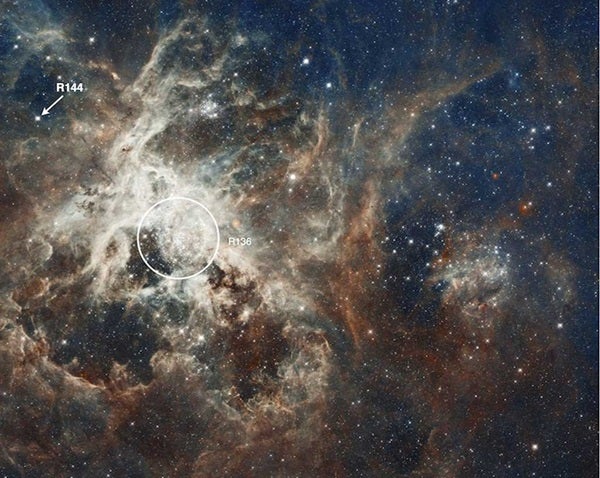The massive binary star R144 is located in an outer area of the star-forming region 30 Doradus in the Large Magellanic Cloud. A number of particularly bright stars can be found in the center of that region with a characteristic pattern of spectral lines. The masses of these so-called Wolf-Rayet stars are up to 250 times the mass of the Sun. R144 is the visually brightest light source of this type in the star-forming region 30 Doradus and radiates strongly in X-rays. This was an indication that R144 is a binary star. Scientists have now confirmed this presumption thanks to the discovery of periodic (orbital) changes in the spectrum.
Astronomers obtained spectra of R144 with the X-shooter spectrograph on the European Southern Observatory’s Very Large Telescope. X-shooter is one of the most sensitive spectrographs on Earth and can observe light from the near-ultraviolet to the near-infrared in one shot. “The identification of this candidate would have been a great challenge without X-shooter. This spectrograph makes observations a lot easier and much more efficient, especially because less observation time is required to cover a large spectral range,” said Hugues Sana from the University of Amsterdam.
The spectrum forms the fingerprint of a star. From the changing shape and position of the spectral lines, it becomes clear that R144 is a binary star. The spectral lines also suggest that the binary system is formed by two hydrogen-rich Wolf-Rayet stars with similar masses, and a current total mass of 200 to 300 solar masses. NGC 3603-A1 was formerly known as the most massive binary star, with a total mass that is equal to 212 times the mass of the Sun.
“It is a mystery how extremely massive stars form,” said Frank Tramper from the University of Amsterdam. “According to the most widely accepted theories, stars of hundreds of solar masses can only form in massive star clusters. The fact that R144 lies far out from the central star cluster in 30 Doradus is possibly an indication that these systems can form in isolation.”
“There is an alternative scenario for the formation of R144,” said Alex de Koter, also from the University of Amsterdam, “namely that R144 was formed in the central star cluster, but that it was ejected by dynamical interactions with other massive stars.” The team is already working on follow-up observations to determine whether R144 is indeed a “runaway” star to definitively establish its mass and its other physical properties in order to decide whether R144 really is the most massive double star discovered so far.










